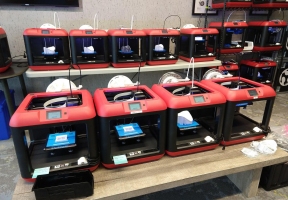
The Field Museum is 3D-printing face shields for healthcare workers and Meals on Wheels volunteers. The Field normally uses 3D printers to make scientific models used for research, educational toys, and materials for visiting field trips. JP Brown, Regenstein Conservator with the Department of Anthropology at the Field Museum, has converted the machines to print NIH-approved face shield support bands. He then attaches, by hand, letter-sized sheets of clear 10 mil Mylar or PVC to make complete face shields. He can produce 25 per day, for an estimated total of 250 before supplies run out. Face shields are made up of a clear sheet of plastic connected to a headband, protecting the wearer’s face from biological hazards. They’re crucial for anyone who works with people closer than six feet, since they act as a hard barrier against infected mucus or respiratory droplets—protecting healthcare workers, first responders, and Meals on Wheels volunteers who deliver food and care to the elderly. Face shields can be resterilized and are reusable until they break.
PHOTO CAPTION: JP Brown makes NIH-approved face shields at the Field Museum’s Regenstein Lab using the museum’s 3D printers. Photo courtesy of JP Brown, Field Museum.









